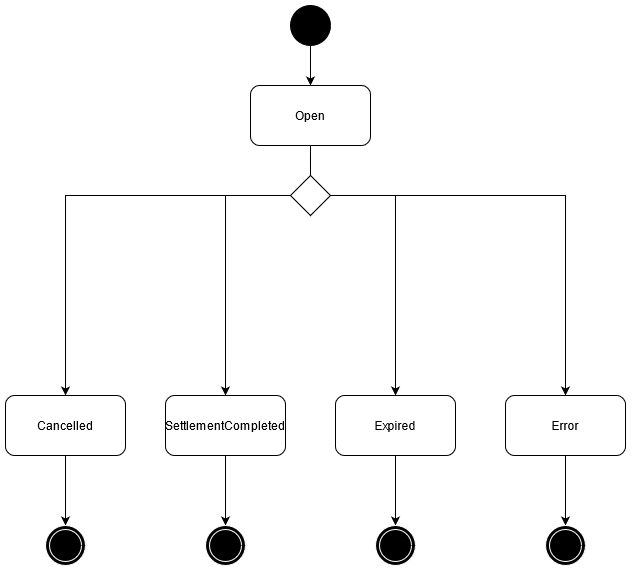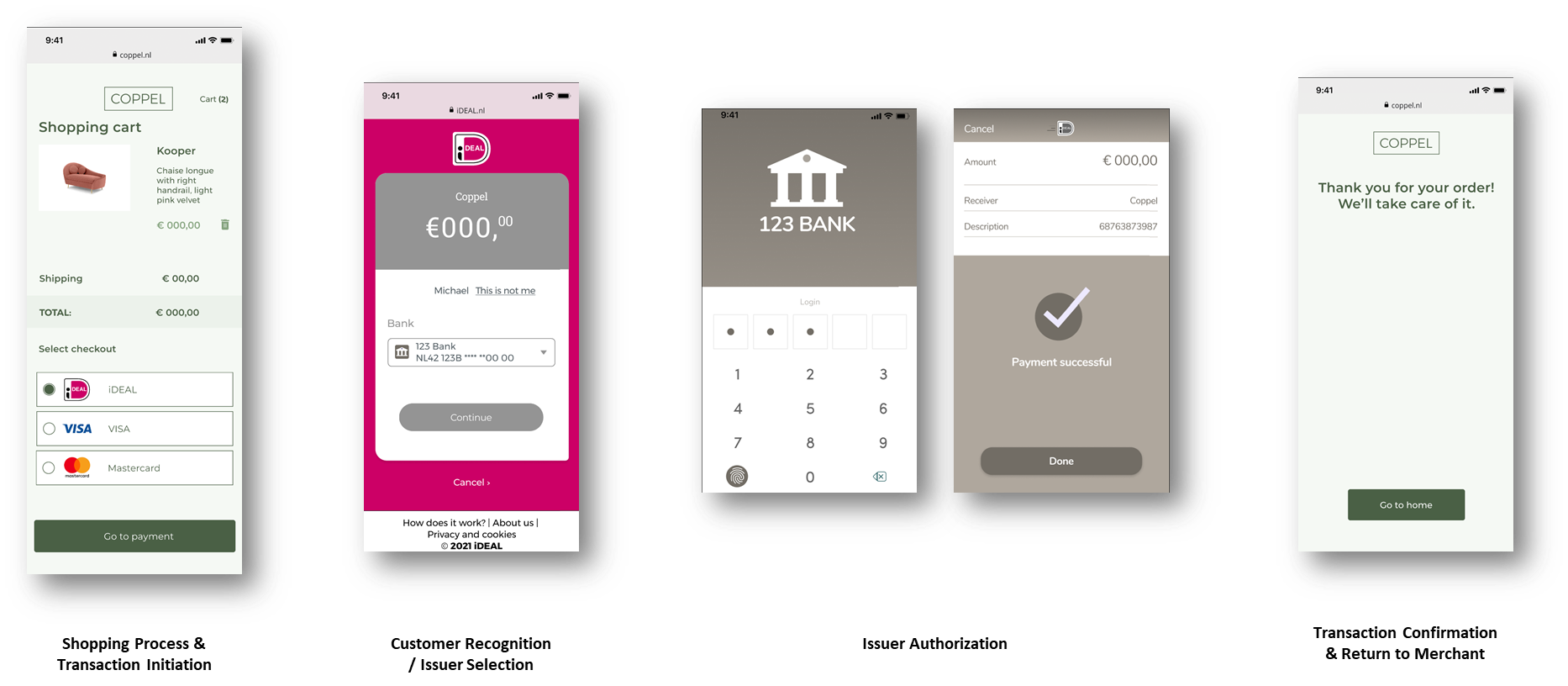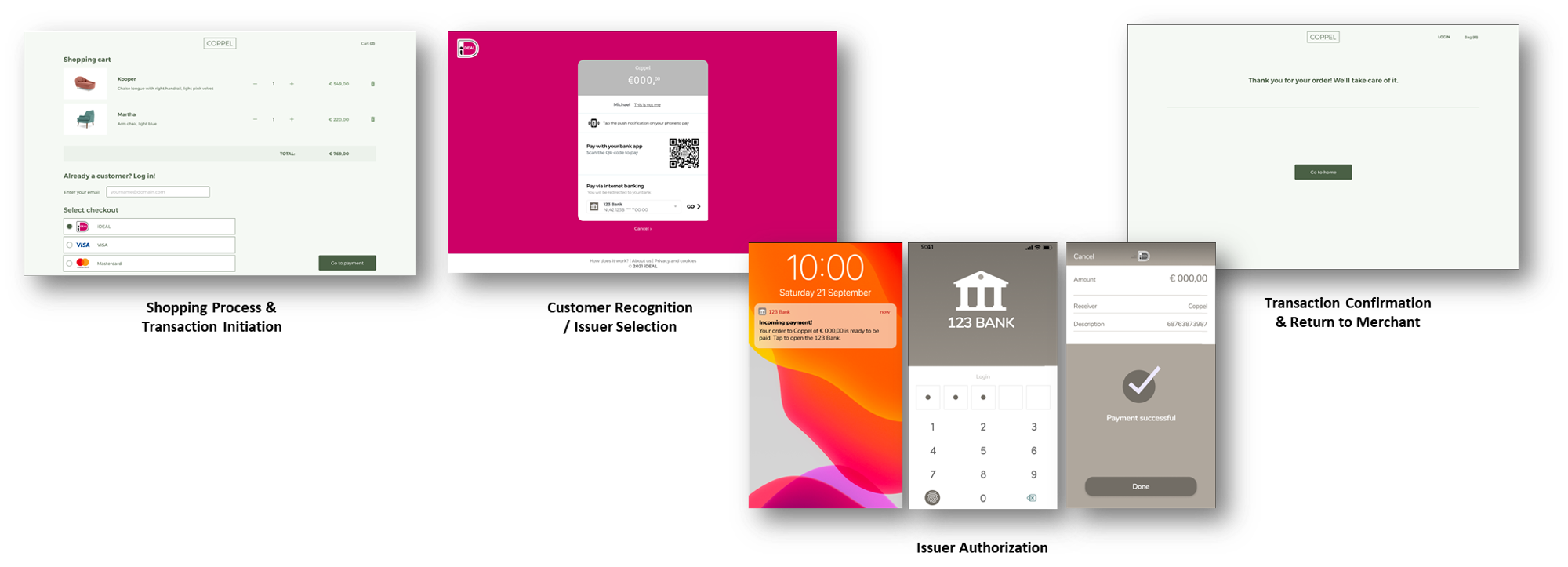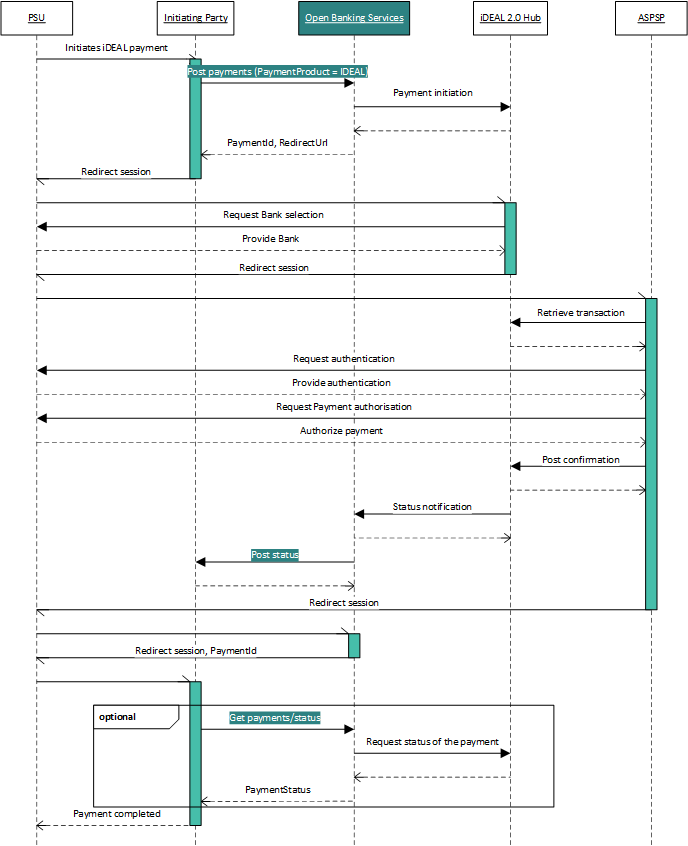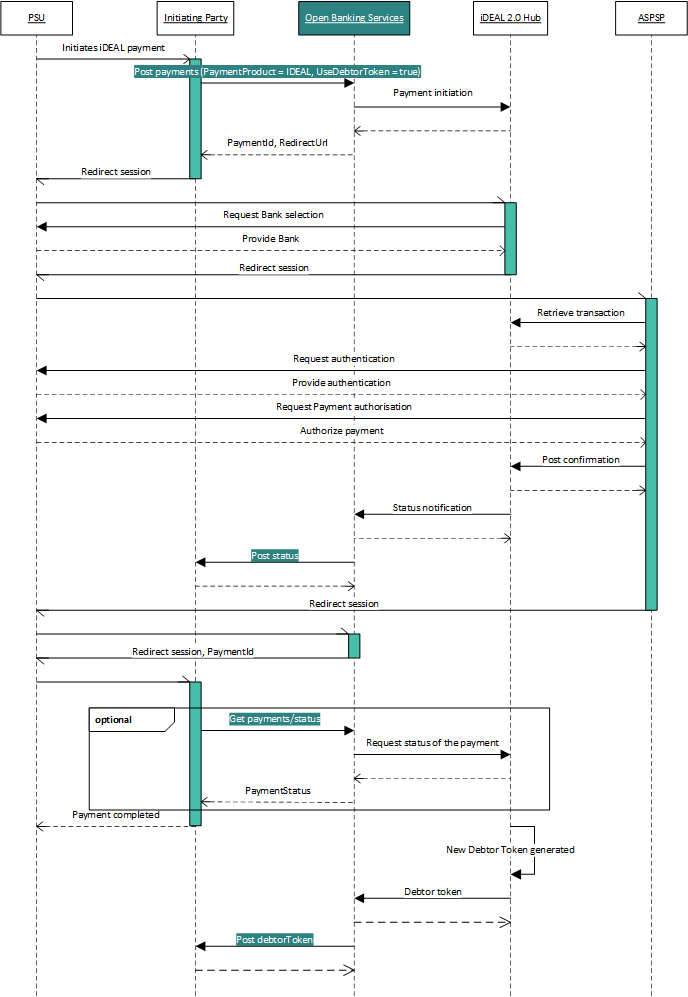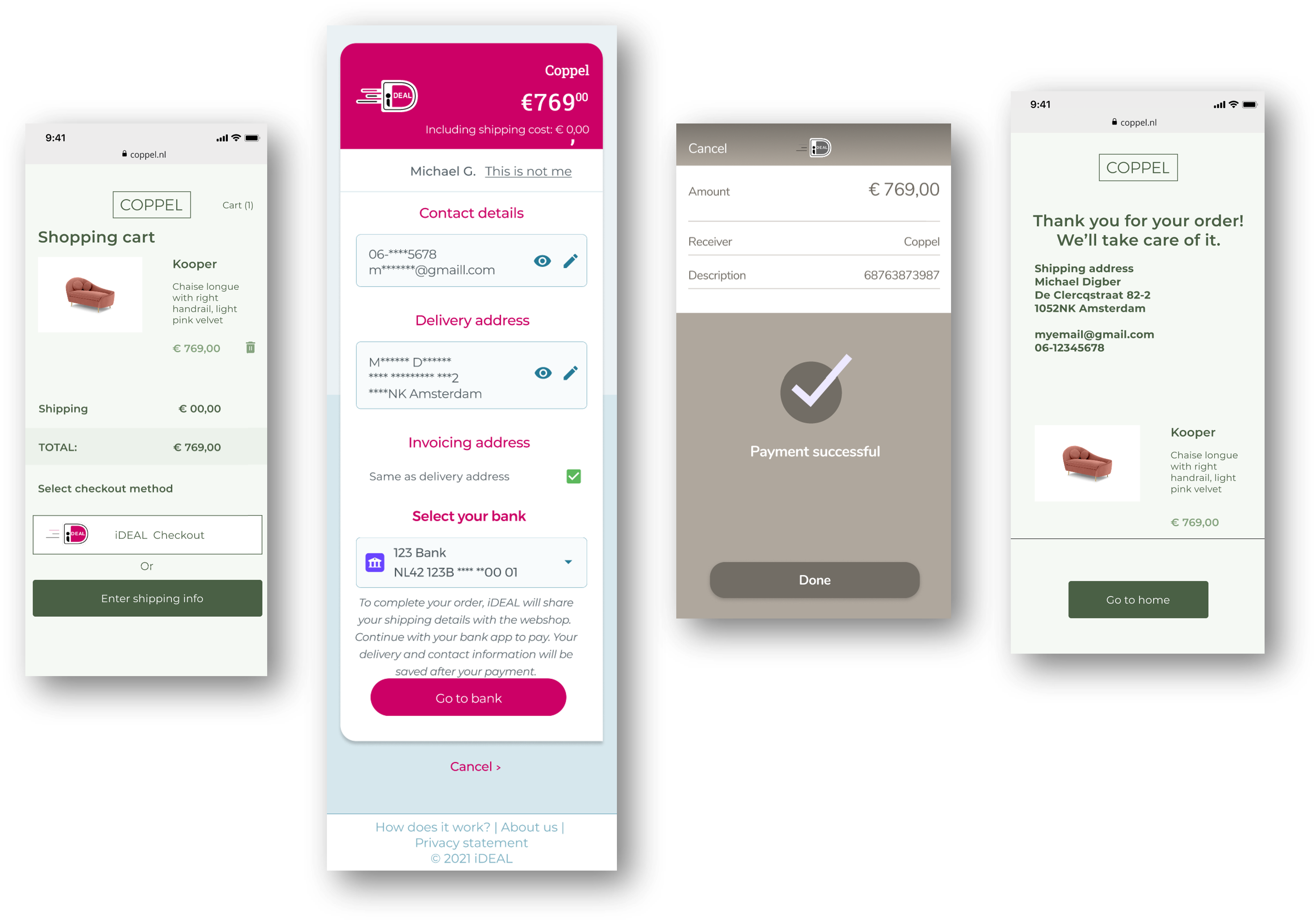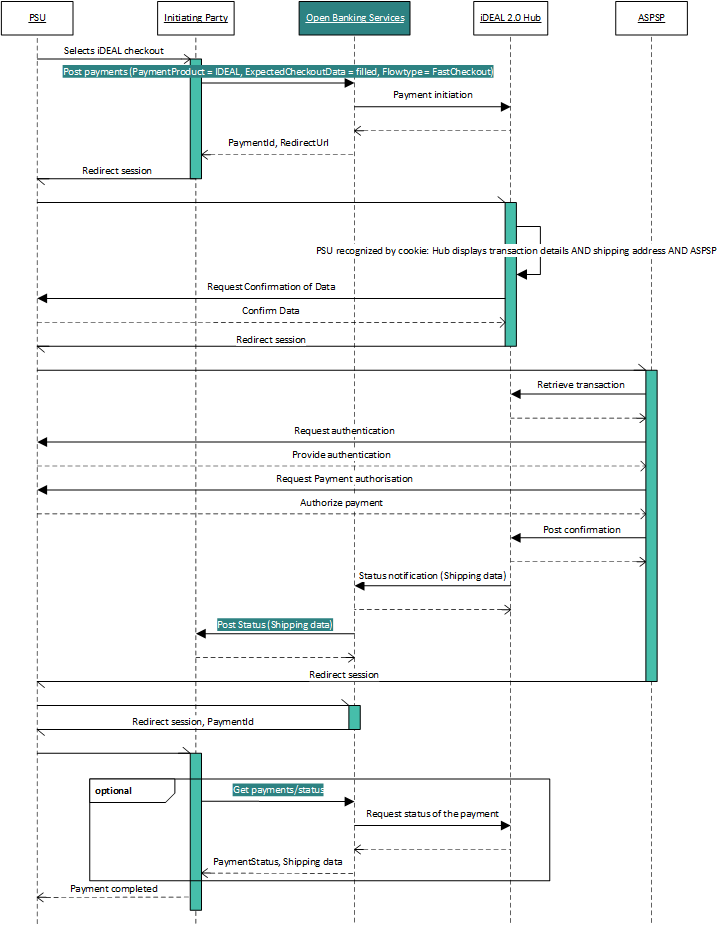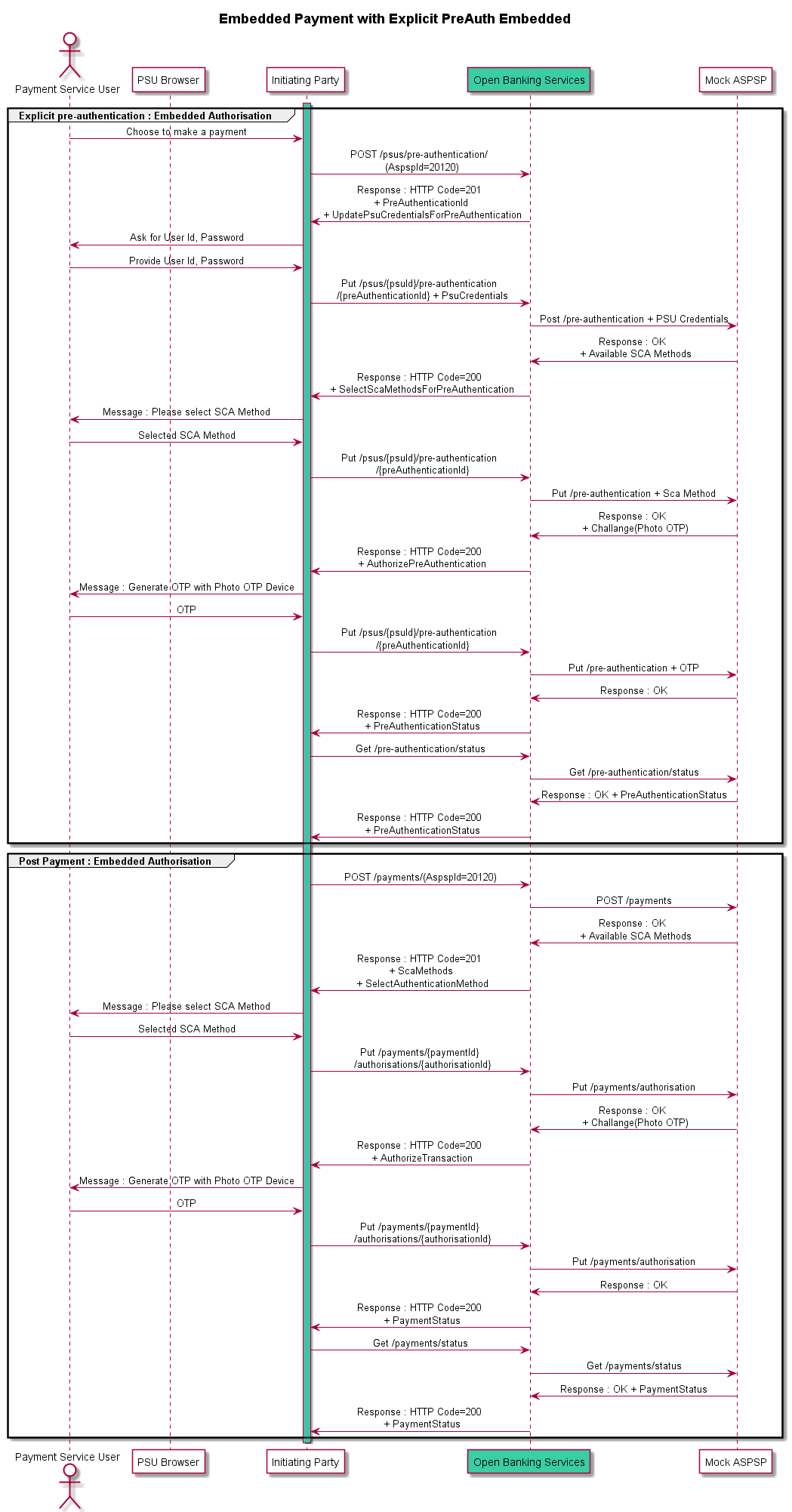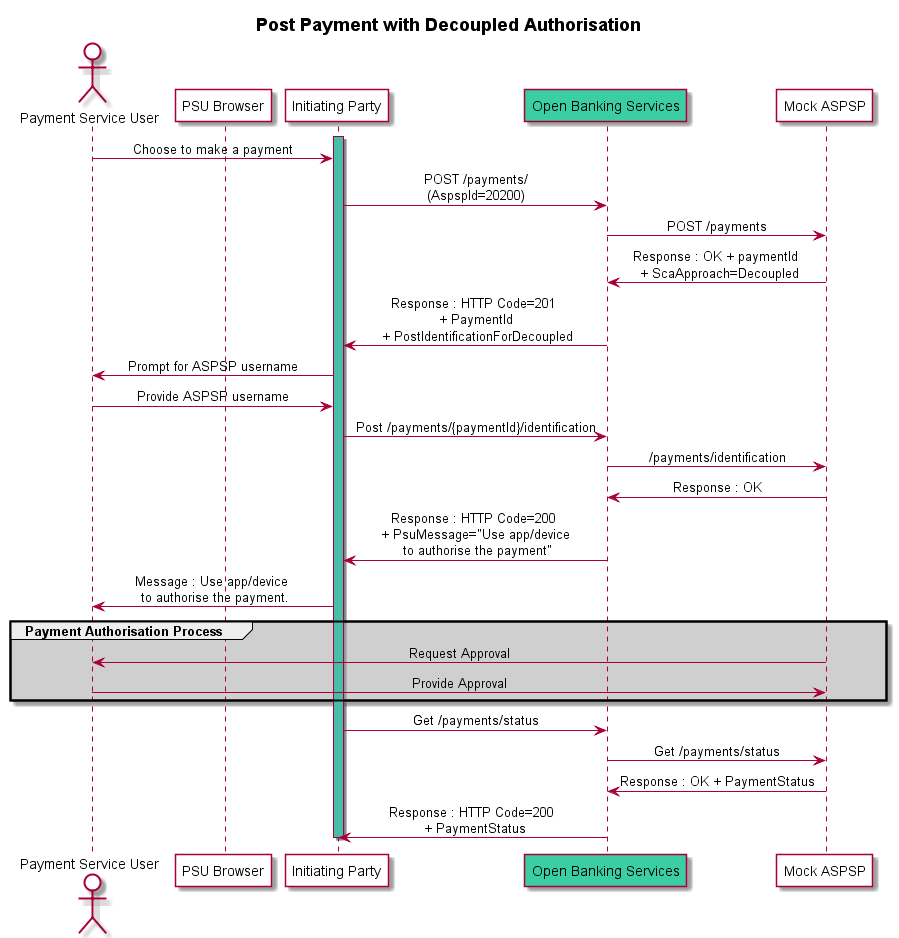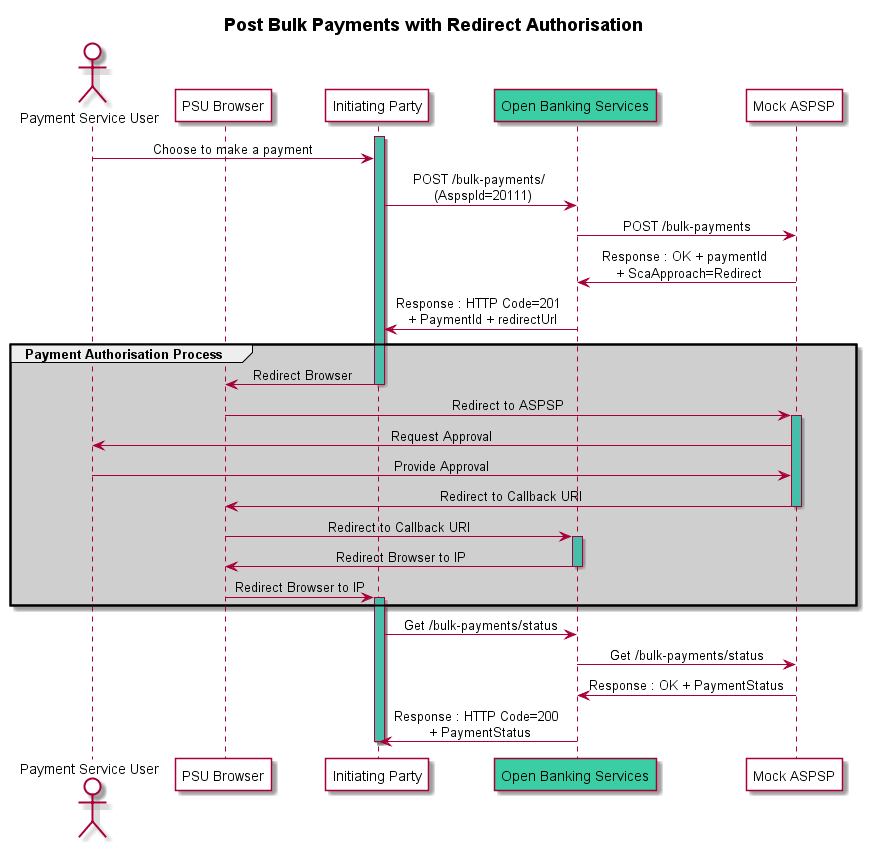ob-p-ideal-pis-api
The iDEAL payment api uses a subset of the available open banking API's. In this chapter only the api's needed for iDEAL payment initiation are described, furthermore the fields applicable to an iDEAL payment are marked purple (optional) and orange (mandatory).
Payment Status
Payments have different status depending on the actual state of processing:
- Open
- SettlementCompleted
- Cancelled
- Expired
- Error
In the following picture the possible iDEAL status are shown in an activity diagram:
POST Payments
Endpoint: POST /payments
The base URL for the payment initiation service API is: /xs2a/routingservice/services/ob/pis/v3
This endpoint is used by the Initiating Party to make an iDEAL 2.0 payment request towards the Open Banking Service.
Information During a prolonged period the Initiating Party is allowed to use the When the
|
Data model
Legend
| |
| Request (click to enlarge) | Response (click to enlarge) |
 | 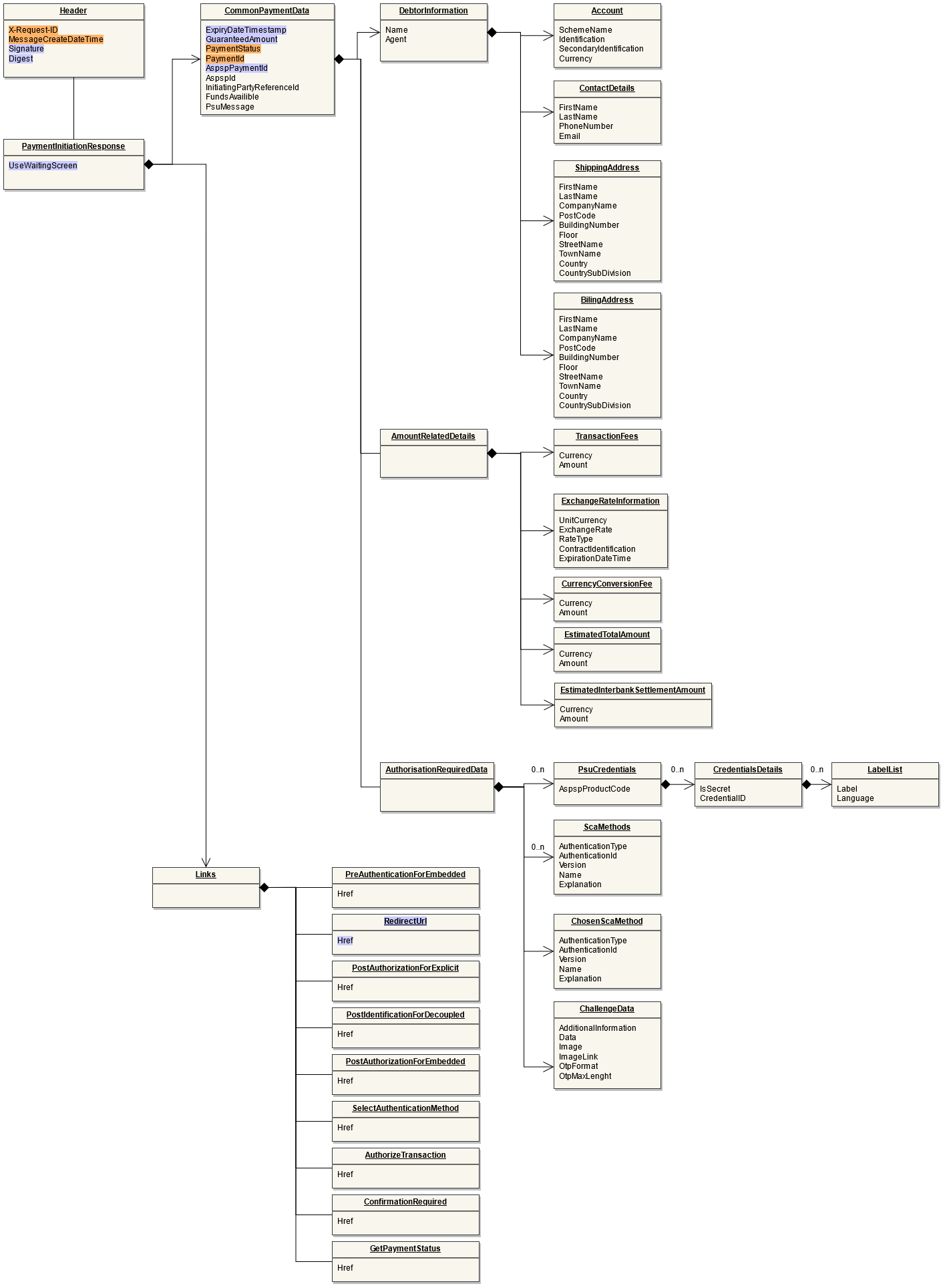 |
Example: Standard iDEAL payment without Debtor token
Request (Signature-related fields "Digest" and "Signature" are conditionally mandatory):
Address: https://digitalroutingservice.awltest.de/xs2a/routingservice/services/ob/pis/v3/payments
HttpMethod: POST
Content-Type: application/json; charset=UTF-8
ExchangeId: b02d7597-3109-4291-86c3-a1d7faaee11c
Headers: {Accept=application/json, Digest=SHA-256=0P2tSst5wZ/1rBS+ZF5Pvp79klNUek7tetk0j9w+mNs=, X-Request-ID=fd3a9dae-5323-ea5a-5460-48857a264b9d, Authorization=Bearer 55aefa2dbd728d28dce18ef04e12e7014cde1e665901bc55ae0be044f114001e, MessageCreateDateTime=2023-12-29T16:38:45.770Z, Signature=keyId="39d8e82bb33e7e2a09cbcb3ef3eab351ee1c5e8f",algorithm="SHA256withRSA",headers="x-request-id (request-target) digest messagecreatedatetime",signature="a94S2WkCTBMdzx3nZrDcA61YkAsesjR9BjKkwvGLEmsCPyEUqk55zYHHE0rLVHwVD7YNchMZnEWFR3Vf63egGSTMPTD0xfmHZJua7Wz/VZVpmIkckCjfYiaQTilVImTcKeBIjhnkAd7MP2qQkr6bDtyQQ1zy1DGwDQgTlNVxOHbv+WcMKJxoQcFn5qLTvaq6fnat3a2Ka/jAUHRytAJ+5xWRT0tKq85LvjB10fho8gMgHQ+4q/0H2gmPhh9QYDwCawbBdgdDWb5HtX0qjhftO3iAb4G5HOlrqSBdTprYVDJmtqwh3YEekfy8KyHifiMMWiKVMrKohAcdvazlSMpKXA=="}
Payload: {
"PaymentProduct": ["IDEAL"],
"CommonPaymentData": {
"Amount": {
"Amount": "1.00"
},
"RemittanceInformation": "iDEAL Standard Flow Minimum fields",
"RemittanceInformationStructured": {
"Reference": "iDEALStandardFlow"
}
}
}
Response (Signature-related fields "Digest" and "Signature" are conditionally present):
ResponseCode: 201
Headers: X-Request-ID=d04820e1-d2da-4def-8def-13062b57d3a6, MessageCreateDateTime=2023-12-29T16:38:45.949Z, Digest=SHA-256=kyULomhnKJVz5IfrMDOWTs5ZpmBTKwjFrF6HO/LQG6s=, Signature=keyId="3EBEF6033C00730D9C6DA05165A3CAA1F31036FB",algorithm="rsa-sha256",headers="messagecreatedatetime x-request-id digest",signature="m//b5oj7D4Vuw5leONeJnlV6P2YvQEPs/fNq9WxE+HsS68iEICh3uMPPwhqv5JLh5UMDudZG0fY/YtvYx3GMUr5DqGaTxplUWW5+l8dV6JM94POvgOveJOPayCMAW0pWd55sbt/IvBJmc19+z6UKMJ5liNwrvYboxYQp3gb9iCeVyqkUPjjDZmo3EvQXV/6gcZAJCNwPy7vAKmGqiI57f/8EJQEZnwopTVMgn77JdpKht/dMw1oulCot4xaxmgcCwwWVxS951yqsNLxKhOnga4zHCe6anjr1F0qL0qZr85z1eDwVfwwAOiv7tGEzGaXszZnOAnsmwMNjktaVvFBPUQ==", Date=Fri, 29 Dec 2023 16:38:45 GMT, Content-Type=application/json;charset=UTF-8}
Payload: {
"CommonPaymentData": {
"ExpiryDateTimestamp": "2023-12-29T20:38:45.925Z",
"PaymentStatus": "Open",
"PaymentId": "142641",
"AspspPaymentId": "0001143558019460"
},
"Links": {
"RedirectUrl": {
"Href": "https://worldline.com"
},
"GetPaymentStatus": {
"Href": "https://digitalroutingservice.awltest.de/xs2a/routingservice/services/ob/pis/v3/payments/142641/status"
}
},
"UseWaitingScreen": false
}
Example: iDEAL Payment with Fast Checkout
Request (Signature-related fields "Digest" and "Signature" are conditionally mandatory):
Address: https://digitalroutingservice.awltest.de/xs2a/routingservice/services/ob/pis/v3/payments
HttpMethod: POST
Headers: {Accept=application/json, Digest=SHA-256=OCbJurWSWF7ltmMlP/kM4oT9C2p5ZEjh4Oh0hcGrzek=, X-Request-ID=8221d7a3-f41b-514f-bbc8-c39a744d145d, Authorization=Bearer 175a6d1c801969021f1071168661d617a17e3f8ba3824b7401491968644d2704, MessageCreateDateTime=2024-02-14T17:33:58.301Z, Signature=keyId="39d8e82bb33e7e2a09cbcb3ef3eab351ee1c5e8f",algorithm="SHA256withRSA",headers="x-request-id (request-target) digest messagecreatedatetime",signature="CAK3vtjrbVlYjtoi5nmor+hGvOTMHGRT4p+hXHU8MnLv5mJvtQRmQVbzujHENclCxTIyQjo01wy/ckBuYdFj1hyJfWW/JPJ0h1qCZX8/XBrI+IA89ZDqNvcd62wUHOcYeFMtIhcySk03Ln7YRjObIJ1g/ky/jB4/aA0UStAWOstc72YU8S2A+5JLy+lN7MzQoV2KNo3QzOyOzPZ9Ga6/2xdMnq7bG+uSBP9n07JljQPoqPr6onsX7UFSjYtind0kX+6wfH2XjQI2pFEhF1q8brL3ponnmQ053JJpp+dX68HFIuDSXn+O9CHL7HLY51xQIbDilPaocA1dPlPLeSsU+Q==", content-type=application/json; charset=UTF-8}
Payload: {
"PaymentProduct": ["IDEAL"],
"CommonPaymentData": {
"Amount": {
"Type": "Fixed",
"Amount": "24.50",
"AmountBreakdown": {
"OrderAmount": "20.50",
"ShippingCost": "4.00"
}
},
"RemittanceInformation": "iDEAL2.0 FastCheckout Flow",
"RemittanceInformationStructured": {
"Reference": "iDEALpurchase21"
}
},
"IDEALPayments": {
"FlowType": "FastCheckout",
"ExpectedCheckoutData": {
"DebtorContactDetails": {
"FirstName": true,
"LastName": true,
"PhoneNumber": true,
"Email": true
},
"ShippingAddress": true,
"BillingAddress": true
}
}
}
Response (Signature-related fields "Digest" and "Signature" are conditionally present):
ResponseCode: 201
Headers: {X-Request-ID=e3727e35-e3fd-4bb9-9c6c-1725da231527, MessageCreateDateTime=2024-02-14T17:33:58.939Z, Digest=SHA-256=16eS+f5lOwGtN05ukpGcKvDrKt2DR5QCNNsDQfLBe5c=, Signature=keyId="3EBEF6033C00730D9C6DA05165A3CAA1F31036FB",algorithm="rsa-sha256",headers="messagecreatedatetime x-request-id digest",signature="RcDMNd5jy/HiJ9s2QxmzwfKuXMTzT4Pk5lp8z0NhOG9fS1VrPVsEcq0u8Hm3C+6UwdPjGDekSC1kytvOm/gHSoZQTIEvpbh99w7yeBCzQNbIQNWr9Fnl4QyXgyrUfVgR889yEGntw+0esl0vu+LpFqi+0CI4rdu5vbzaqLz/oG00D9NC8W0PfEmj469XBevp3hDcnb6ieINmOVo4ZYu2ByaD3p6TC1vN+YYRqw6t/n+qZVjYG3DIhceTtiqsPvoucU7wYVRplqta7GyAK9RGevXzZfY6guiZrsDHl6mWhToKiQoS2YjGE6COF89oOeCfC5NXy4n+/fwKAhqmWBdPsQ==", Date=Wed, 14 Feb 2024 17:33:58 GMT, Content-Type=application/json;charset=UTF-8}
Payload: {
"CommonPaymentData": {
"ExpiryDateTimestamp": "2024-02-14T21:33:58.919Z",
"PaymentStatus": "Open",
"PaymentId": "174142",
"AspspPaymentId": "0001077680035886"
},
"Links": {
"RedirectUrl": {
"Href": "https://worldline.com"
},
"GetPaymentStatus": {
"Href": "https://routingservice.awltest.de/xs2a/routingservice/services/ob/pis/v3/payments/174142/status"
}
},
"UseWaitingScreen": false
}
GET Payment Status
Endpoint: GET /payments/{paymentId}/status
This endpoint is used to retrieve the status of a payment.
Data model
Legend
| |
| Request | Response (click to enlarge) |
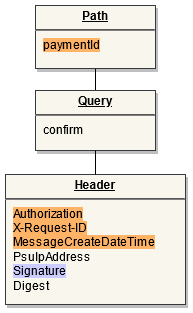 | 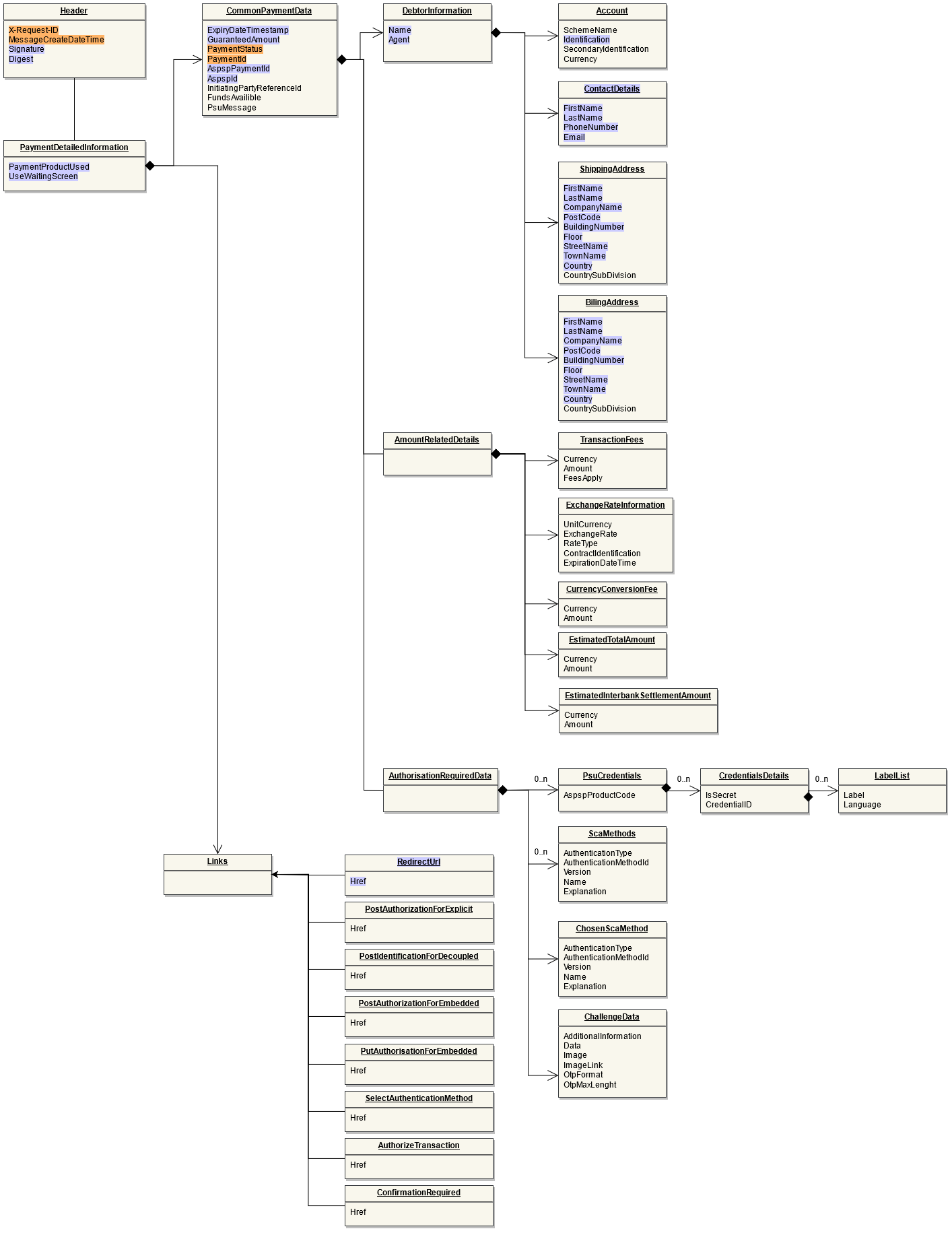 |
Example: iDEAL payment status
Request (Signature-related fields "Digest" and "Signature" are conditionally mandatory):
Address: https://digitalroutingservice.awltest.de/xs2a/routingservice/services/ob/pis/v3/payments/143374/status
HttpMethod: GET
Headers: {Accept=application/json, Digest=SHA-256=47DEQpj8HBSa+/TImW+5JCeuQeRkm5NMpJWZG3hSuFU=, X-Request-ID=aa9ec3e7-dc34-f625-2e97-e16644ea1e77, Authorization=Bearer 59519322f1f56db6bd1d23ac0e22cf5015088f085970fb9b461ff2684bc2e96a, MessageCreateDateTime=2024-01-08T12:55:34.630Z, Signature=keyId="39d8e82bb33e7e2a09cbcb3ef3eab351ee1c5e8f",algorithm="SHA256withRSA",headers="x-request-id (request-target) digest messagecreatedatetime",signature="W/6ViHZJ/x0/KM61H7mwCZQp2/3WPax5seqLpCby0BXwgpVoFrSmCu5oHF2pLS2AdHuTiE6qFsBnMkfeGMEDwtqCdY0GZVQGwZ6j9+6zjJHwm21xZ+BmXXH4puRgqxt7DSnOou3SkstzCblf4gSL8MqIyYu7n+eLQlWvjl57t7dNgX0sNTwJE/1GgU/ukDyUoJl4aO1n9ID8EnLDUpXunbZ+1pyCPGbfz5/pDMrJsKZ9l58tLxj7IneU+Mnai8UJEqrQ441ONgYCHF7KoDxu15XA+IY7DnwkA5u/+QN7IY5KpHG3zP19m7jiOimkI6lrqLAc2Ld4iehjNMGve7Ci7w=="}
Response (Signature-related fields "Digest" and "Signature" are conditionally present):
ResponseCode: 200
Headers: {X-Request-ID=3a3df5d3-fa9e-4fee-b9fd-067c23dc91fa, MessageCreateDateTime=2024-01-08T12:55:35.032Z, Digest=SHA-256=pV9HQh/XGpLmawhfj9d/hxYucKkOQCKV9BJ978PeW5k=, Signature=keyId="3EBEF6033C00730D9C6DA05165A3CAA1F31036FB",algorithm="rsa-sha256",headers="messagecreatedatetime x-request-id digest",signature="DMvxRTvhRG1kFAy0JPbBzdoRrXq5C9OUJHl6GMQkdNriG4SeuHGaFpdaDA6NgFw2+Ky/RBYiruL18ul+1ZvmdhlyhMaRqR0J7Jg/m9JMyu3wFunBVINysQ+2yj0ucXRMck/CoBW1mYwjDCGCN7xOofw2mZLV6PHjP9xHaDA855iPYE7HUaukB/qveA/S6B2qsjFxDs5AJh6VSWEoknA1+NJZCEX2VC23bnkMgy92qN6bZch5bL3462yFA/0uA75k9XH3O7+Jesl86tBU3kKATNk5n2//vun+Bg4NlSQjU21m6B+nOZT1M+TUkVzG0KWdByf6yFv/x0rp7hifnFZvjA==", Date=Mon, 08 Jan 2024 12:55:35 GMT, Content-Type=application/json;charset=UTF-8}
Payload: {
"PaymentProductUsed": "IDEAL",
"CommonPaymentData": {
"PaymentStatus": "SettlementCompleted",
"PaymentId": "143374",
"AspspPaymentId": "0001092688873027",
"AspspId": "10002",
"DebtorInformation": {
"Name": "Edsger Wybe Dijkstra - Callback",
"Agent": "ABNANL2AXXX",
"Account": {
"SchemeName": "IBAN",
"Identification": "NL44RABO0123456789"
}
}
}
}
